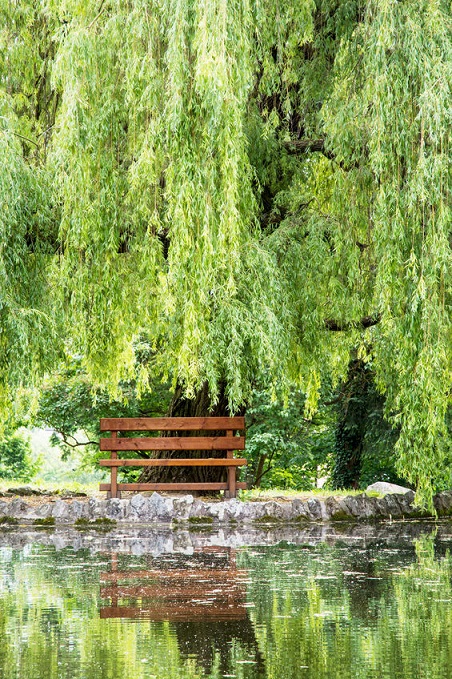 Willow trees grow in every continent except Australia and Antarctica. There’s 500 species worldwide, including black, crack and almond willow, but of those, 1 has graduated to become the darling of DIY acne enthusiasts.
Willow trees grow in every continent except Australia and Antarctica. There’s 500 species worldwide, including black, crack and almond willow, but of those, 1 has graduated to become the darling of DIY acne enthusiasts.
It’s the white willow tree, or salix alba, and specifically the bark, taken from 2-3 year old willows. These mystical trees grow between 30 and 100 feet tall and thrive in wet soil and riverbanks. It’s not surprising that acne-clearing powers have been theorised. With their pale colour and magical swaying leaves like an entrance to an enchanted forest, they’re like an icon of naturalness.
Legends are plentiful; knocking on a willow tree supposedly allows you to store your secrets inside the wood.
Medieval British believed that storing chopped willow wood would unleash a curse on your family, yet the Chinese hung willow branches on their doorsteps to keep evil spirits away. Their wood is ideal for divining rods, and if a girl throws 13 shoes into a willow tree and one of them gets caught, she is destined to be married within the next year.
Fancy becoming a fortune teller? Take 99 leaves from 99 different willow trees, grind them into ash and eat it, and the power of prophecy will be yours to wield.
More importantly, does white willow bark really cure acne?
The central claim is false
The main bread and butter fact, spread far and wide on skincare forums, is that white willow bark is a natural source of pharmaceutical salicylic acid.
You’ve probably heard of, maybe even been tempted by this popular topical remedy. It’s used in 2% chemical peels to rejuvenate the skin’s outer layer. Salicylic acid is a phenolic aromatic acid, although in marketing, it’s regularly dubbed a beta hydroxy acid to exploit the popularity of alpha hydroxy acids like glycolic acid.
Unlike the water-soluble AHAs, salicylic acid is fat soluble. Consequently, it drives into your skin’s oil (sebum) like a mole digging a hole, and once inside, salicylic acid exerts keratolytic properties. Essentially, it breaks down the keratin protein bonds in dead skin cells. Your pores unclog, a rainbow forms on the horizon, and the acne train is derailed.
Salicylic acid is undeniably effective, but can also be harsh and irritating. The FDA allows only 2% quantities to be bought from drugstores.
Therefore, the theory goes that white willow bark has these amazing powers too, but this time, they’re complimented by soothing natural goodness. Labels regularly say “a natural source of salicylic acid”, giving the impression that they’re 100% interchangeable.
But here’s the fatal flaw: willow bark does not contain salicylic acid. It contains a closely related “salicylate” compound called salicin, which acts totally differently.
Similar but different
 The whole story started back in 1543BC Ancient Egypt, where the Ebers Papyrus medical text referred to white willow for calming fever and pain.
The whole story started back in 1543BC Ancient Egypt, where the Ebers Papyrus medical text referred to white willow for calming fever and pain.
More recently though, the Royal Society convened for a grand medical conference in 1763, and one letter read out was from Reverend William Stone. One day in 1758, he had accidentally tasted willow bark, and his pain and fatigue symptoms vanished.
After gathering and drying willow bark from nearby riverbanks, he had successfully calmed the pain of 50 malaria patients over the previous 5 years. White willow exploded in popularity, replacing the exotic and expensive Peruvian bark.
For 65 years, European scientists searched in vain for the magic compound. Finally, in 1828, Joseph Buchner isolated some yellow crystals. Salicin was discovered, and 10 years later, the Italian Raffaele Piria split salicin molecules into sugar and a new compound called salicylaldehyde. By oxidising the later, he created the very first batch of salicylic acid.
Later on, in 1898, Felix Hoffman (the father of heroin) altered salicylic acid to create aspirin, raking in millions, but the point is that salicylic acid is not simply ripped straight from willow bark. It has a natural source, but is created in a laboratory.
Likewise, salicin’s effects are different in the body to its grandson. When eaten, salicin moves to the lower intestine and is fermented by gut bacteria and enzymes into saligenin. Likewise, saligenin is fermented into salicylic acid, immediately entering the bloodstream.
However, this conversion process only occurs in the stomach, with digestive juices flowing around. It’s physically impossible when rubbed into the skin using a topical white willow cream.
Topical strawberries have a similar myth orbiting them. They’re claimed to be rich in natural salicylates, and while they do contain 1.36mg per 100 grams, raspberries contain 3.14mg, apricots contain 2.58mg, and blueberries 2.76mg. It’s a classic internet tale which has stuck like superglue. So that’s the first myth dealt with…
…but white willow is still great for skincare!
However, don’t get the idea that we’re completely trashing white willow bark. It works both ways – salicin achieves things that salicylic acid could only dream of.
Pain has remarkably similar root causes to red and vicious pimples. Its reputation is a red herring, but check out this promising hard data:
ONE: scientists analysed almost every condition except for acne itself. After deliberately scratching human skin cells, wound healing after 24 hours fell from 65% to 35% using the inflammatory chemical lipopolysaccharide, but white willow bark reversed this. The translation is pimples that appear and vanish in the blink of an eye, instead of lingering in the mirror.
For inflammation, topical white willow bark dampened the pivotal immune system cytokines interleukin-6 and interleukin-8. Acne-prone skin cells have a strong correlation with IL-8 levels; even IL-8 genes are hyperactive. Meanwhile, Il-1a was unaffected, another important inflammatory cytokine, so white willow isn’t 100% flawless.
Most fascinatingly though, white willow bark cut off an increase in IGF-1. This dairy hormone is vital for skin cell growth, but overdoses lead to oily skin mayhem. White willow also upregulated a gene called FOXO-1, confirmed to make androgen receptors less responsive in the skin, making existing testosterone, DHT and IGF-1 less potent. White willow bark could be a shield that allows you to eat more strawberry yogurt (2017 study).
TWO – to the scientists’ shock, applying 0.5% concentration salicin twice daily improved wrinkles, roughness, pore size, radiance and overall appearance after a single week. After four weeks, firmness, pigmentation, and jawline sharpness improved. After twelve weeks, hydration and elasticity improved. Better yet, no side effects were detected. Their conclusion seemed tailor made for DIY acne maniacs: “salicin has the ability to reduce the visible signs of skin aging when applied topically.” (2010 study).
THREE – part two of the epic quest for the fountain of youth. This time, salicin beneficially affected gene families dubbed “youth clusters”.
Specifically, salicin downregulated matrix metallo protein 9, an enzyme responsible for recycling existing collagen, the youth protein. Genes controlling collagen production were increased.
So were the skin’s hyaluronic acid synthases (HAS1 and HAS2), which manufacture, guess what, hyaluronic acid, the natural glycosaminoglycan moisturiser which skincare titans are boastfully adding to their formulas. Overall, the white willow bark compound created “a more youthful gene expression” (2011 study).
History suggests anti-inflammatory properties
 Back in 5th century BC, father of medicine Hippocrates recommended chewing on the bark for pain, and the juice for soothing women’s labour pains.
Back in 5th century BC, father of medicine Hippocrates recommended chewing on the bark for pain, and the juice for soothing women’s labour pains.
The Roman physicians Celsus and Galen targeted redness, heat, swelling and pain (sound familiar?). As a native European species, the Romans had the bark at their fingertips, and it spread far and wide in their gigantic empire.
Traditional Chinese used willow bark for – wait for it – soothing pain. However, the most fascinating is easily Native America. Tribes like the Cheyenne used flexible willow wood to carve arrow shafts, but also chewed the bark as a primitive mouthwash to relieve nagging gum aches. They also boiled willow bark into tea.
Evidence stretches back 1400 years. In 2023, archaeologists unearthed 4 pottery fragments in an ancient cave in east Colorado, alongside ancient knives and scraping tools. They expected a food jar, but found no traces of vegetables or meat.
Instead, the residues had a 73-90% match to salicylic acid from willow. Radiocarbon measurements dated the jars to between 586 and 692AD.
Strangely, no other substances were detected, implying that it was strictly a medicine pot, a sacred jar used to carry exclusively herbal remedies without cross contamination.
Effectively, the tribes were using a rudimentary form of aspirin, and it illustrates the power of willow bark perfectly. Whisper it – could the Native Americans have discovered an incredible natural cure for acne? A sacred pot could easily imply a beauty-making, ceremonial connection.
As for anti-ageing powers? No reports in ancient times. However, wrinkles require much more patience, diligently applying the bark for several weeks. Therefore, it’s much less likely than a Greek warrior or Egyptian pharaoh would have stumbled upon them.
Likewise, a red, swollen flesh wound is a matter of life and death. Native Americans hunting buffalo without a comfy armchair to relax into probably had far less time to experiment with wrinkles. Therefore, the missing historical evidence is easily outweighed by the amazing studies.
Antioxidant mania
Furthermore, white willow bark is a highly complex substance. Salicylates get all the attention, but like a raspberry on a nearby farm, or a pineapple on a faraway tropical island, white willow bark has flavonoids and anthocyanin galore:
Rutin – 1.75mg per 100 grams.
Salicin – 3.99mg.
Chlorogenic acid – 1.65mg.
Epicatechin – 1.17mg.
Quercetin – 0.38mg.
Gallic acid – 0.17mg.
Naringenin – 0.20mg.
Rutin is already famed for widening your capillaries and allowing blood to refresh your skin with glow. Raspberries (11.00mg per 100 grams), asparagus (23.19mg), and black olives (45.36mg) are the greatest food sources, but what about topically?
Apparently, rutin can prevent UV damage from sunlight (study). Not wrinkles and inflammation directly, but the warped proteins and immune actor COX-2 that lead to it. The sequel study found a sun protection factor (SPF) score of 30, close to the chemical UV filter homosalate added to sunscreens.
Chlorgenic acid, meanwhile, can accelerate wound healing in rat skin (study). It’s another member of the sunscreen society; in this study it beat 10 other plant-borne antioxidants for UVA radiation absorption.
That’s taking for granted the bread and butter antioxidant capabilities. Rather than diffusing in the body, their topical powers will be hyper concentrated. Furthermore, the tests only searched for famous antioxidants (quercetin and rutin are everywhere), not obscure, potentially powerful ones unique to willow.
But what about the other species? All was revealed in this study on seven. Fascinatingly, the French salix amplexicaulis has 10 times more rutin (22.09mg), and purple willow had 4.30mg.
For total flavonoid antioxidants, white willow bark was 4th of 7th (3.48mg), but again, s. amplexicaulis (20.64mg) and purple willow (31mg) soared above the rest. Phenolic antioxidants were much closer, with 40.9mg, 49mg and 69.1mg respectively, and the signature compound salicin is particularly topsy turvy.
Almond willow (2.87mg) and olive willow (2.60mg) contain the least, followed by crack willow (3.47mg) and Babylon willow (3.11mg), whereas s. amplexicaulis (8.29mg) and purple willow (7.53mg) are on another planet.
Despite its awesome reputation, white willow could be kicked of its skincare throne with a sharp thud. It’s beaten resoundingly by two obscure European species.
Its free radical deactivation was also middling. White willow was dead last for the common DPPH scale (scoring 1.83), beaten four fold by salix triandra, AKA the almond willow (7.79), which stretches from south east England to Croatia. However, on the OH scale it was 4th of 7 (34.76), this time beating almond willow (28.01).
Therefore, the specific acne powers could vary massively by species. White willow could end the grimy skin from air pollution, while purple willow could make mutated toxins from deodorant irrelevant. White willow could be your armour in a sun scorched heatwave, compared to cigarette smoke protection for almond willow.
The hard bottom line, though, that white willow bark is rich in promising antioxidants.
How does it rank in the halls of acne?
The biggest problem with white willow bark is easily that its powers seem selective. We just discussed how its free radical properties varied massively by the testing scale used. With inflammation, IL-8 and IL-6 were blocked but IL-1a was unchanged.
Therefore, there’s huge scope for firing a massive blank with acne; an unlucky roll of the dice which means that none of its powers translate. Fever, yes, pain definitively, but p.acnes bacteria can be very specific, targeting the toll-like receptor 2 gene to unleash an inflammatory barrage. It also churns out lipases, which digest your skin’s natural oils and pump out toxic waste products.
That said, it would have to be a truly freak set of circumstances for acne not to benefit at all.
Compared to earth-shattering topical treatments like tamanu oil, there’s definitely less evidence. White willow bark automatically falls short of remedies tested directly on acne. These included green tea, which once reduced acne by 32.5%, tea tree oil, by 40.49% (study), and mangosteen by 67% (study). I can’t recommend a 6 week experiment if you’re a natural newbie, with so many unexplored opportunities.
Nothing about white willow is unique either. For example, lavender oil particularly cracks down on inflammatory immune system neutrophils, giving it potential for one person’s highly specific condition, despite being invisible to the naked eye.
Shea butter already rolls collagen and anti-inflammation into a tidy package. The antioxidants like rutin are plentiful, but not sky high. A quest to the purple willow forests of Turkey might be more rewarding.
However, the lack of studies is a bonus too, giving more scope for undiscovered greatness. It’s similar for antioxidants – I would bet that unique ones are awaiting discovery right now.
If we were locked in a laboratory and judging purely on studies, anti-ageing would be the main appeal. The anti-inflammatory powers would be solid but unspectacular, but combined with the Native American history books, they become a juggernaut.
Another advantage is no side effects. Taken orally, there are fears over pregnancy problems and medication interactions, but topically, the evidence suggests it’s harmless.
The final verdict
White willow bark is promising for two classic skincare quests: reducing inflammation and slowing ageing.
The ageing mechanisms will benefit acne indirectly too, like hyaluronic acid and collagen sprouting up as far as the eye can see. I do NOT instantly recommend sneaking out with your night vision goggles and slashing a chunk of bark off a tree at 2am with your trusted machete (you’ll probably fall in the river anyway).
Instead, white willow is one to file away under massive promise and a potential experiment, much like hops in beer, which we recently covered.
Again, it’s history that really makes the difference to white willow bark. Studies make it decent, but the Native American legends make it fascinating.
Thanks for reading!